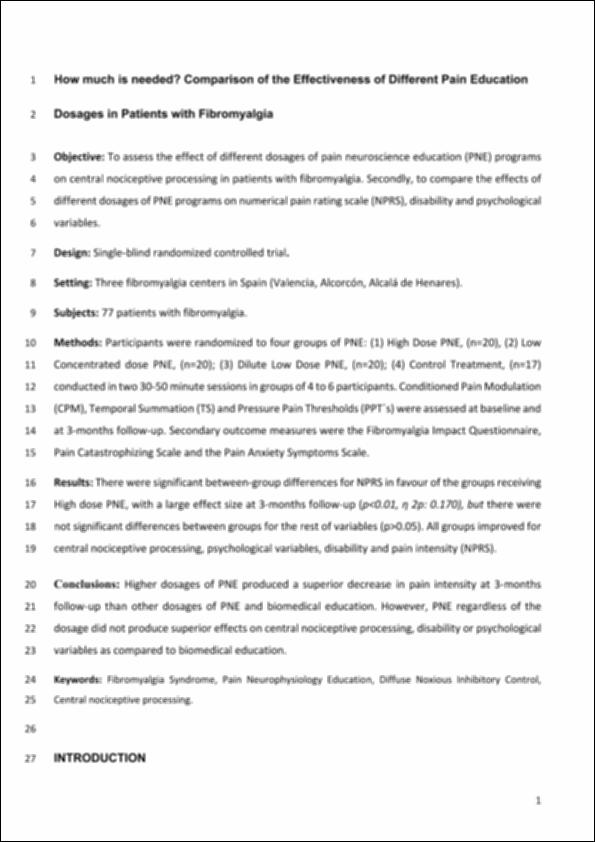Please use this identifier to cite or link to this item:
http://hdl.handle.net/10637/15175How much is needed?: comparison of the effectiveness of different pain education dosages in patients with fibromyalgia

See/Open:
How_Amer_PM_2020_postprint.pdf
338,86 kB
Adobe PDF
See/Open:
How_Amer_PM_2020.pdf
Restricted Access
447,89 kB
Adobe PDF
Request a copy
| Title: | How much is needed?: comparison of the effectiveness of different pain education dosages in patients with fibromyalgia |
| Authors : | Amer Cuenca, Juan José Pecos Martín, Daniel Martínez Merinero, Patricia Lluch Girbés, Enrique Nijs, Jo Meeus, Mira Ferrer Peña, Raúl Fernández Carnero, Josué |
| Keywords: | Fibromialgia; Fibromyalgia; Dolor crónico; Chronic pain; Tratamiento médico; Medical treatment; Fisioterapia; Physical therapy; Terapia; Therapy |
| Publisher: | Oxford University |
| Citation: | Amer-Cuenca, J.J., Pecos-Martín, D., Martínez-Merinero, P., Lluch Girbés, E., Nijs, J., Meeus, M., Ferrer Peña, R. & Fernández-Carnero, J. (2020). How much is needed?: comparison of the effectiveness of different pain education dosages in patients with fibromyalgia. Pain Medicine, vol. 21, i. 4 (apr.), pp. 782–793. DOI: https://doi.org/10.1093/pm/pnz069 |
| Abstract: | Objective: To assess the effect of different dosages of pain neuroscience education (PNE) programs on central nociceptive processing in patients with fibromyalgia. Second, to compare the effects of different dosages of PNE programs on numerical pain rating scale (NPRS), disability, and psychological variables. Design: Single-blind randomized controlled trial. Setting: Three fibromyalgia centers in Spain (Valencia, Alcorcón, Alcalá de Henares). Subjects: Seventy-seven patients with fibromyalgia. Methods: Participants were randomized to four groups of PNE: 1) high-dose PNE (N = 20), 2) low-concentrated dose PNE (N = 20), 3) diluted low-dose PNE (N = 20), and (4) control treatment (N = 17), conducted in two 30-50-minute sessions in groups of four to six participants. Conditioned pain modulation (CPM), temporal summation (TS), and pressure pain thresholds (PPTs) were assessed at baseline and at three-month follow-up. Secondary outcome measures were the Fibromyalgia Impact Questionnaire, Pain Catastrophizing Scale, and Pain Anxiety Symptoms Scale. Results: There were significant between-group differences for NPRS in favor of the groups receiving high-dose PNE, with a large effect size at three-month follow-up (P < 0.01, η2p = 0.170), but there were no significant differences between groups for the remaining variables (P > 0.05). All groups improved for central nociceptive processing, psychological variables, disability, and pain intensity (NPRS). Conclusions: In patients with fibromyalgia, higher dosages of PNE produced a larger improvement in pain severity at three-month follow-up than other dosages of PNE and biomedical education. However, PNE was not superior to biomedical education in the central nociceptive processing, disability, or psychological variables in patients with fibromyalgia. |
| Description: | Este artículo es la versión postprint, siguiendo la política de acceso de la editorial Oxford University Press. This is the peer reviewed version of the following article: Amer-Cuenca, J.J., Pecos-Martín, D., Martínez-Merinero, P., Lluch Girbés, E., Nijs, J., Meeus, M., Ferrer Peña, R. & Fernández-Carnero, J. (2020). How much is needed?: comparison of the effectiveness of different pain education dosages in patients with fibromyalgia. Pain Medicine, vol. 21, i. 4 (apr.), pp. 782–793, which has been published in final form at: https://doi.org/10.1093/pm/pnz069 Este es el post-print del siguiente artículo: Amer-Cuenca, J.J., Pecos-Martín, D., Martínez-Merinero, P., Lluch Girbés, E., Nijs, J., Meeus, M., Ferrer Peña, R. & Fernández-Carnero, J. (2020). How much is needed?: comparison of the effectiveness of different pain education dosages in patients with fibromyalgia. Pain Medicine, vol. 21, i. 4 (apr.), pp. 782–793, que se ha publicado de forma definitiva en: https://doi.org/10.1093/pm/pnz069 |
| URI: | http://hdl.handle.net/10637/15175 |
| Rights : | http://creativecommons.org/licenses/by-nc-nd/4.0/deed.es |
| ISSN: | 1526-2375 1526-4637 (Electrónico) |
| Issue Date: | Apr-2020 |
| Center : | Universidad Cardenal Herrera-CEU |
| Appears in Collections: | Dpto. Enfermería y Fisioterapia |
Items in DSpace are protected by copyright, with all rights reserved, unless otherwise indicated.

